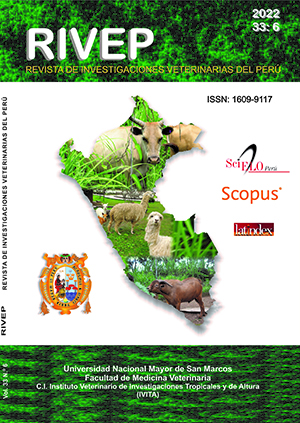Zoonotic hepatic helminths and their histopathological characterization in Rattus spp from a zoo, pig farm and food markets
DOI:
https://doi.org/10.15381/rivep.v33i6.24104Keywords:
Rattus spp, C. fasciolaris, C. hepatica, zoonosisAbstract
The study aimed to determine the prevalence of zoonotic liver helminths and their histopathological characterization in rodents (Rattus spp.) from a zoo, pig farms and food markets in Lima, Perú. The morphometric parameters of each rodent were recorded to determine the age and identify the species, computing a total of 267 animals. The handling and the capture methodology were carried out according to the biosafety standards established by the Center for Infectious Diseases and Prevention of Atlanta. Livers were macroscopically evaluated for lesions. For diagnostic confirmation by histopathology, samples were taken from the right lateral lobe of all the livers together with other areas that showed damage in search of tissue lesions and inflammatory response related to the presence of the parasites. The pathological analysis determined a prevalence of 3.74% of Cysticercus fasciolaris in Rattus spp. without finding Capillaria hepatica. Statistical analysis did not show a statistically significant association between the study variables and C. fasciolaris. The most common histopathological diagnosis was moderate to severe granulomatous eosinophilic cholangiohepatitis associated with C. fasciolaris. The results indicate that rats can be sources of C. fasciolaris infections in various environmental settings, therefore, they allow us to understand the health risk of the zoonoses they transmit and their management.
Downloads
Downloads
Published
Issue
Section
License
Copyright (c) 2022 Gustavo Chuquillanqui Trujillo, Amanda Chávez Velásquez, Rosa Pinedo Vicente, Deisy Abad-Ameri, Omar Gonzales-Viera, Alfonso Chavera Castillo

This work is licensed under a Creative Commons Attribution 4.0 International License.
AUTHORS RETAIN THEIR RIGHTS:
a. Authors retain their trade mark rights and patent, and also on any process or procedure described in the article.
b. Authors retain their right to share, copy, distribute, perform and publicly communicate their article (eg, to place their article in an institutional repository or publish it in a book), with an acknowledgment of its initial publication in the Revista de Investigaciones Veterinarias del Perú (RIVEP).
c. Authors retain theirs right to make a subsequent publication of their work, to use the article or any part thereof (eg a compilation of his papers, lecture notes, thesis, or a book), always indicating the source of publication (the originator of the work, journal, volume, number and date).










